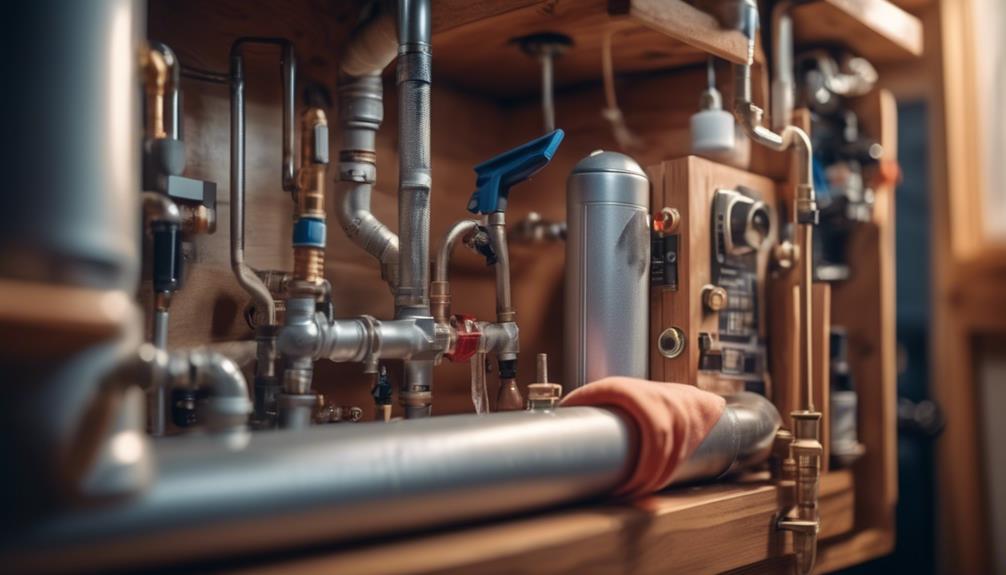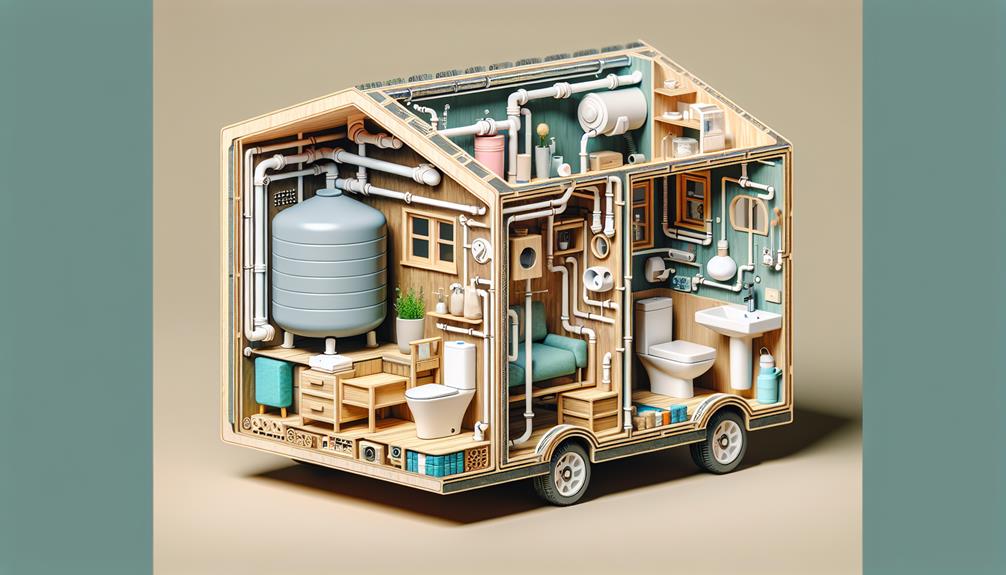In the world of housing, size matters in unexpected ways; while traditional homes often grapple with the luxury of space, tiny homes bring you face to face with the ingenuity of compact living. As you marvel at the minimalist square footage, you might find yourself puzzled by the mechanics of essential systems—particularly, how plumbing operates on such a reduced scale.
Inside these pint-sized dwellings, every inch counts, and the plumbing system is a marvel of space-saving design and multifunctionality. You're likely familiar with the standard plumbing in conventional homes, but the solutions that tiny home dwellers employ—from water supply to waste management—might surprise you.
Imagine being able to maintain self-sufficiency with rainwater collection or composting toilets, all while navigating building codes and environmental considerations. Stick with this exploration, and uncover the intricacies of tiny home plumbing that enable a comfortable, sustainable lifestyle, even in the most compact of spaces.
Key Takeaways
- Tiny homes have a compact plumbing system that separates water into distinct tanks for fresh, grey, and black water.
- PEX lines are used for flexibility and easy installation of water supply to fixtures.
- Tankless water heaters are preferred for hot water due to their on-demand capabilities and spatial economy.
- Insulating pipes and tanks is important to prevent freezing and ensure efficient functioning of the plumbing system.
Understanding Tiny House Plumbing
To effectively manage water resources in a tiny home, you'll need to navigate a compact plumbing system that segregates water into distinct tanks for fresh, grey, and black water, each requiring specific handling and disposal methods.
Your tiny house water supply must be meticulously designed to maintain efficiency in a constrained space. Utilizing PEX lines for their flexibility and ease of installation, you can ensure a reliable water supply to fixtures, including the shower drain. For hot water, a Tankless Water Heater is often preferred for its on-demand capabilities and spatial economy.
Moreover, you must prioritize pipe insulation to combat the risks of freezing in cold climates.
The grey water tank collects used water from sinks and showers, which can be sustainably repurposed or discharged responsibly.
Water Supply Solutions
Having outlined the intricacies of tiny house plumbing, let's now explore the array of water supply solutions that cater to both on-grid and off-grid living scenarios.
Your tiny home can sustainably manage water usage with these systems:
- On-Grid Water Source: Connect via a water inlet to a municipal line or outdoor faucet, utilizing PEX pipe for your cold water and supply lines, ensuring consistent water flow.
- Off-Grid Tanks: Install a tank to store water, coupled with a reliable electric water heater or a propane-powered hot water heater for thermal efficiency.
- Water Heating Solutions: Choose between traditional tank-based, on-demand tankless, or electric water heaters based on your energy preferences and space constraints.
- Innovative Cold Water Systems: Implement cutting-edge PEX piping for durable, flexible water lines, optimizing the footprint within your compact space.
Waste Management Systems

When designing your tiny home's waste management system, it's essential to differentiate between greywater and blackwater disposal methods to ensure environmental compliance and operational efficiency. Implementing a composting toilet can dramatically reduce blackwater production, circumventing the need for a main drain and simplifying waste management systems.
Greywater, however, may be efficiently processed through a French drain, provided local regulations permit.
Ensure that your PVC drain infrastructure is robust to avoid scenarios where drain lines won't drain, potentially necessitating a Whole House Shut to fix any problems. Regular maintenance is vital, especially in colder climates, to prevent freeze-induced blockages.
For those seeking cutting-edge solutions, explore incinerating toilets, which further minimize reliance on traditional plumbing works and facilitate off-grid living.
Heating Tiny Home Water
Selecting the appropriate water heating system is crucial for your tiny home's comfort and functionality, with options ranging from electric heaters for stationary homes to propane units for those embracing an off-grid lifestyle. Your choice should be driven by efficiency, space, and energy source availability.
Here's what you need to consider:
- Electric Water Heaters: Ideal for homes with reliable grid power; ensure your hot supply is consistent.
- Propane Units: A viable solution for heating water in mobile or off-grid conditions.
- Tankless Systems: These water heaters provide on-demand hot water, reducing plumbing costs and conserving space.
- Insulation Strategies: Utilize heat tape around PEX bends and insulate lines within your tiny home to prevent heat loss.
Plumbing System Maintenance

While considering the efficiency and space-saving benefits of your water heating options, it's equally important to establish a routine for plumbing system maintenance to ensure longevity and prevent costly repairs. Insulating your pipes and fixtures is crucial, especially in the colder months to prevent freezing.
Here's a concise table to help you prioritize maintenance tasks:
| Maintenance Task | Frequency | Key Components |
|---|---|---|
| Inspect and insulate pipes | Seasonally | Pipe, Insulation, Heater |
| Greywater/Blackwater | As per regulations | Disposal System, Sanitation |
| Leak and blockage checks | Monthly | Pipe, Joints, Sink and Shower |
| Heater and tank servicing | Annually | Water Heater, Temperature Gauge |
Innovatively, integrating these practices into your regular upkeep routine will contribute to the efficient functioning of your plumbing in a Tiny House, ensuring that hot water flows seamlessly into the tiny confines of your bathroom and kitchen. Remember, the need to service your system regularly cannot be overstated.
Frequently Asked Questions
How Does the Plumbing in a Tiny Home Work?
You'll find space-saving fixtures and innovative solutions, like greywater systems which aid in water conservation. Compact appliances, durable plumbing materials, and off-grid options are key, ensuring optimal water pressure despite seasonal challenges and simplifying maintenance.
How Do Tiny Homes Deal With Sewage?
You'll navigate sewage like a pro with composting toilets, cutting-edge greywater systems, and compact sewage tanks. Off-grid solutions minimize environmental impact, while septic options and municipal connections offer varied waste disposal pathways.
Where Does the Water Go in a Tiny House?
In your tiny house, water from various sources is managed through efficient greywater systems and filtration techniques, with rainwater harvesting supplementing water storage. Off-grid solutions often include pumps and fixture choices designed for maximum water conservation.
How Do Bathrooms Work in a Tiny House?
You'll marvel at the ingenuity of tiny house bathrooms, where space-saving fixtures and wet baths epitomize dual-purpose design. Composting toilets, greywater systems, and innovative water-saving techniques ensure functionality meets eco-conscious off-grid options.
Conclusion
In conclusion, mastering tiny home plumbing intertwines sustainability with innovation. You're not just installing pipes; you're weaving a self-reliant tapestry that marries conservation with comfort.
From rainwater collection to waste management, each component is pivotal. Ensure regular upkeep to maintain your system's integrity. Embrace this eco-centric approach, and you'll not only contribute to a greener planet but also secure a reliable, efficient water system for your compact haven.
Remember, the essence of tiny living is in the details.

